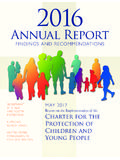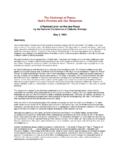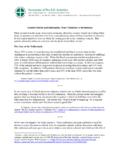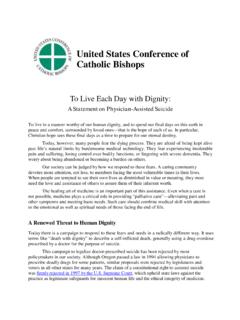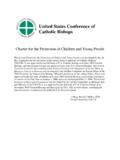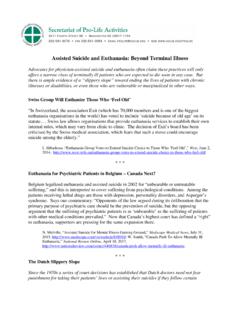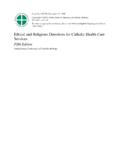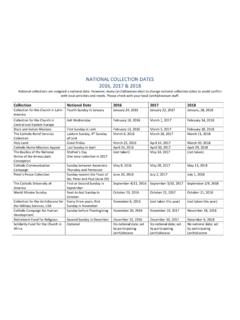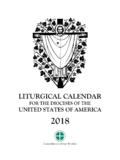Transcription of Safe Environment Training - usccb.org
1 COMMISSIONED WORK: NOT TO BE DISTRIBUTED WITHOUT THE EXPLICIT PERMISSION OF THE AUTHOR. safe Environment Training : The Effectiveness of the Catholic Church s Child Sexual Abuse Prevention Programs Authored by: Kavita Desai, Esq. Staff Attorney Dawn Lew, Esq. Senior Staff Attorney CHILDREN AT RISK Institute 2900 Weslayan, Suite 400 Houston, TX 77027 office: fax: 1 Table of Contents I. Introduction ..2 II. Methodology ..5 III. Summary of A. Surveys from the Church ..7 B. Studies of effectiveness of prevention programs ..12 IV. Analysis ..18 A. Ideal prevention programs ..18 B. Criticisms of programs ..21 C. Responses to criticism ..23 D. Other prevention models ..25 E. Limitations of research ..25 V. Conclusion ..27 Tables ..29 References ..32 2 I. Introduction Sexual abuse is a crime that leaves a significant scar in the lives of victims, and the consequences can be especially severe when the victim is a child.
2 Abused children may face serious long-term difficulties with psychological and mental health (Mikton & Butchart, 2009). Victims of sexual abuse are often at a higher risk for depression, anger, substance abuse, sexual difficulties, self-destructive behavior, and sexual revictimization (Lalor & McElvaney, 2010). While the exact number of incidents is difficult to measure, it has been well documented that child sexual abuse occurs across a broad spectrum of socioeconomic and ethnic groups (Topping & Barron, 2009). Unfortunately, not even houses of worship are immune from the occurrence of abuse. In 2002, reports on the sexual abuse scandal within the Archdiocese of Boston brought to light a broader crisis facing the Catholic Church in the United States. In the summer of 2002, the United States Conference of Catholic Bishops ( usccb ) responded to the sexual abuse problem by issuing the Charter for the Protection of Children and Young People (the Charter) which has been revised twice since its inception.
3 In addition to implementing other policies and procedures related to child abuse, Article 12 of the Charter requires that all dioceses and eparchies institute safe Environment Training and education for children, youth, parents, ministers, educators, volunteers and others ( usccb safe Environment Work Group, 2007, p. 1). These programs seek to prevent child abuse by educating ministers, parents, children, and those who work or volunteer with children. All dioceses and eparchies must implement safe Environment programs for both children and adults, but the Charter is silent on the details of the program requirements. Rather, program approval is entrusted to the bishop of the jurisdiction. Consequently, the structure, content, thoroughness, and details of programs in particular dioceses may vary. 3 The Catholic Church has delineated guidelines to assist dioceses in implementing programming that is consistent with the values and catechism of the Church, is age appropriate, that instructors feel comfortable presenting, and that address potential parental concerns ( usccb safe Environment Work Group, 2007).
4 To this end, the Committee for the Protection of Children and Young People and the National Review Board of the United States Conference of Catholic Bishops created the safe Environment Work Group. The safe Environment Work Group consulted with a panel of theologians, educators, catechetical leaders, child psychologists and safety Training practitioners to develop assumptions and criteria for use in the selection of safety Training materials ( usccb safe Environment Work Group, 2007). The assumptions include that: Lessons in safety Training for children will include annual Training with ongoing reinforcement at home. Age appropriate lessons in safety Training will begin no later than kindergarten and continue through high school. Basic curriculum criteria will be similar at all levels with wording, application and examples being different.
5 ( usccb safe Environment Work Group, 2007, p. 4). The criteria for safe Environment Training are rooted in Article 364 of the Catechism of the Catholic Church, which states that the human body shares in the dignity of the image of God ( usccb safe Environment Work Group, 2007, p. 4). The criteria are divided by age groups, with the following points appropriate for all grade levels: Parts of our bodies are considered private and we respect these in self and others. I am a person loved by God and deserving of respect. 4 There is a difference between safe and unsafe touch. It is all right to say no to violation of personal space. It is important to report abuse of self or others until one is believed. There are strategies to help protect oneself. ( usccb safe Environment Work Group, 2007, p. 4-5). For grades 7-12, the safe Environment Work Group adds the teaching that a healthy relationship requires individuals to support the life and dignity of one another in all aspects ( usccb safe Environment Work Group, 2007, p.)
6 5). For grades 9-12, they include the concepts that all persons have the right to expect personal and vocational lives free of harassment, and that every person has the obligation to ensure that those whom he or she leads or supervises are free of harassment ( usccb safe Environment Work Group, 2007, p. 5). safe Environment programs may be self-generated or obtained from commercial vendors. The VIRTUS programs, which derive their name from the Latin word for valor, moral strength, excellence and worth, are one set of commercial programs commonly used by dioceses, and their format is informative of safe Environment programs in general. The adult program, Protecting God s Children, consists largely of two video presentations involving the testimony of offenders, victims, and experts (Hudson, 2012). A trained facilitator leads participants through written exercises and group discussion.
7 Keeping the Promise Alive was introduced in 2009 as a refresher program for adults who had previously completed Protecting God s Children, and there is also online Training available for continuing education. VIRTUS child program is entitled Touching Safety and includes an introductory video, a teaching guide for adults, and lesson plans. The program consists of four age groups each receiving two lessons per year in an attempt to deliver age appropriate lessons. 5 Recent audits of compliance with the Charter indicate that safe Environment programs have been implemented in the vast majority of dioceses and eparchies (Secretariat of Child and Youth Protection, 2012). Since its inception in 2002, safe Environment Training has been provided to over million children, who represent of all children who must receive Training under the Charter.
8 Additionally, Training has been received by over 99% of both clergy and educators, as well as 96% of relevant employees and volunteers. While the implementation of safe Environment programs is high, the question remains as to whether these programs are effective. This paper seeks to answer that question by reviewing literature on the effectiveness of child sexual abuse prevention programs, identifying the core components and best practices associated with successful programs, and comparing the insights of research with the initiatives put into place by the Church. The findings indicate that child sexual abuse prevention programs can be effective in increasing knowledge about sexual abuse, improving self-protective behaviors, and raising disclosure rates, but that the Church s safe Environment programs could be improved by universal implementation of the best practices in the field.
9 II. Methodology The goal of this paper is to review the current literature available on child sexual abuse prevention programs and to compare the Catholic Church s programs to the best practices in the field as identified by scholars. The first source of information examined in determining the state of safe Environment Training came from the Catholic Church s internal surveys, documents, and evaluations conducted by the Catholic Church regarding their child sexual abuse prevention programs. Two surveys were conducted at the behest of the United States Conference of Catholic Bishops of the child-focused safe Environment Training programs, one in 2006 and another in 2010. The surveys contain a variety of information about the implementation and 6 effectiveness of the safe Environment Training programs offered by the Church. An additional survey of the VIRTUS Protecting God s Children program, which is adult-directed sexual abuse prevention Training , was conducted in 2010, and is also included here.
10 Additionally, the report of the usccb safe Environment Work Group (2007) offered a comprehensive look at the guidelines the Catholic Church established for the implementation of child abuse prevention programs, and listed recommendations, goals, and the rationale behind the continued mission to provide safe Environment Training from the Church s perspective. The National Review Board of the United States Conference of Catholic Bishops conducted a request for information from academic scholars and other interested parties on the effectiveness of the Catholic Church s safe Environment Training . The journal articles provided as part of that request for information are presented here, as well as responses from several professional risk management and child abuse prevention organizations that were willing to provide input as to their best practices for prevention Training .
